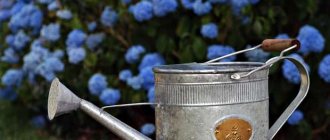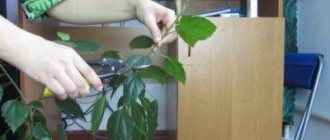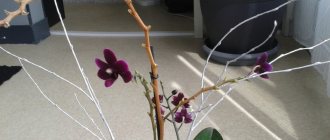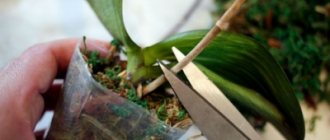A luxurious, truly royal look is given to hydrangea by its lush inflorescences of pastel colors. She delights her admirers from May to October, lavishing aroma and decorating garden plots with the delicate colors of flowers. To achieve the appearance of such beauty, you should put some effort into growing this plant and constantly caring for it. The abundant flowering of bushes largely depends on a procedure such as pruning. Different types of plants require special rules to be followed during the process. Their exact observance will respond with gratitude in the form of abundant flowering of the bushes.
Spring pruning
First you need to determine the type of plant, because this determines what kind of pruning is needed. Plants are divided into 2 groups, flowering on shoots:
- Last year (large-leaved);
- Current year (tree-like, paniculate species).
Lush blooming of beautiful hydrangea
How to prune hydrangea in spring depends on the type of plant.
Pruning of hydrangeas of the first group in the spring should be done carefully, removing only dried inflorescences and weak shoots damaged in winter. The standard one is inappropriate here, it will deprive the bushes of flowering.
Having chosen the appropriate time: day and month, they begin to work. The step-by-step process occurs in the following order:
- Thin out the bush (tree).
- Remove weak branches, retreating from the surface of the ground to the width of your palm.
- The shoots located inside the bush are cut out.
- Branches damaged by frost are cut off at the level of “living” wood.
After finishing the work, the bush is fixed to the support and tied up.
Autumn treatments with hydrangeas in the garden
In cold climates, gardeners are afraid to radically prune hydrangeas for the winter: wounds remain on the branches and shoots that do not have time to heal before the onset of cold weather, which makes the plant vulnerable to frost. If you prune completely and leave the plant in this form for the winter, moisture and infections that get into the wounds will lead to cell death.
In the fall, it is safe to prune dried inflorescences on adult plants - this is also true if the plant is covered for the winter. During heavy snowfalls, numerous inflorescences are dangerous for the bush: under the weight of the snow, the wood becomes deformed, breaks off, or the shoots bend to the ground; in the spring they will have to be tied up so that they get used to growing vertically again.
On a note.
Pruning paniculata hydrangea largely depends on the shape that needs to be given to the plant: bush, bush with a raised crown, standard with an erect or raised crown.
Types of pruning
Caring for hydrangea in spring - how to properly replant hydrangea
Proper pruning includes several types:
- Standard haircut that is done every year. You need to trim the bush to create a strong plant with abundant flowering.
- Formative - to give the plant the required configuration and optimal arrangement of skeletal branches.
- Sanitary – removal of damaged, old shoots, dried inflorescences.
- Rejuvenating – carried out on heavily damaged and old bushes.
Why do you need to prune hydrangea paniculata in spring?
There are several types of pruning that are used for paniculate hydrangea:
- Sanitary.
This procedure is used to remove broken and dried branches and shoots that have frozen over the winter. Sanitary pruning means any actions related to cleaning the bush, reducing the likelihood of outbreaks of infections and pests on it. In addition to spring, this procedure must be carried out in the fall, and in emergency cases it can be done in the summer. Important! In case of severe mechanical damage or damage to the bush, sanitary pruning should be radical; shoots are removed to stumps 40-50 cm long. The bush will not bloom next year, but such an extreme measure helps save the plant from death. - Rejuvenating. Carry out to stimulate the growth of new shoots. During this procedure, old branches on which flowering no longer occurs are removed to the base. After rejuvenating pruning, the bush should contain about 10 young strong shoots.
- Formative. This type of pruning is required for a young panicle hydrangea bush to ensure that the bush grows evenly and has the correct shape.
- Standardizing or regulating. This is done to give the bush fullness, as well as to regulate the number of flower stalks.
Different types of pruning are usually combined depending on the age of the bush, since they are carried out at once and at the same time.
Dates
How to water garden hydrangea correctly
They often use spring pruning, when the snow has not yet melted. The procedure begins with the swelling of the growth buds, since they determine the choice of branches that need to be trimmed. Usually this is the month of March or early April. In addition, specific weather conditions must be taken into account. Even if the buds are swollen, the event should be postponed if cold weather returns. But you can’t put it off for a long time, because the plant must have time to develop growths that will bloom within its standard time frame.
The duration of this operation also depends on the type of plant. Tree hydrangea develops more slowly than paniculata; it will take more time to form shoots, so work should be carried out earlier (March). For paniculata, late pruning (in April) is suitable. For large-leaved flowers, you need to do it in early spring, but keep in mind that it blooms on last year’s shoots.
Why prune hydrangea, when and how to do it correctly
The pruning procedure for hydrangea is carried out so that the inflorescences in the future will be large and the bush will delight with lush flowering. If you do not cut off unnecessary inflorescences, then the bush itself will become quite thickened, which will lead to the formation of small flowers. In addition, it is used to ensure that the grower has the opportunity to form a bush of the desired shape. For the purpose of shaping, you need to remove only all those inflorescences that are very small. As a result, the gardener grows only powerful and lush shoots or just 1 standard.
Other nuances that indicate the need for regular pruning include:
- giving the bush a beautiful decorative appearance;
- formation of the correct shape;
- obtaining full and large flowers;
- the ability to turn an ordinary bush into a standard plant.
Did you know? By adjusting the alkalinity and acidity of the soil, each gardener can independently control the color saturation of the hydrangea.
In addition to the question of why to prune hydrangea, people often ask when, namely in what time period it will be correct to implement this procedure.
The peculiarity of such a plant is that it is pruned during the following periods:
- in autumn;
- in spring;
- in summer.
Depending on the purpose of pruning, a specific period is selected during which this action will be carried out. Autumn is the best period for pruning tree and paniculate hydrangeas . This can be done even after the very first frost has passed. This is due to the fact that with the sudden onset of cold weather, the leaves from the plant will quickly fall off and only bronze dry inflorescences will remain. This way, you can quickly determine which shoots you should get rid of and which ones you should leave.
Video: Pruning tree hydrangea in autumn
Therefore, in the autumn season, the best period is considered to be the end of October or the beginning of November . As for a season like spring, during this period it is also possible to prune both tree and paniculate hydrangeas. But it is better if this action is carried out in several stages: one part is cut off in the fall, and the second in the onset of spring. Only spring pruning should be done for large-leaved hydrangeas.
Important! After autumn pruning of inflorescences, it is very important to prepare the hydrangea shrub for future wintering.
Summer is considered an infrequently used period, but during this season such manipulations are carried out if the gardener wants to constantly care for the appearance of the plant and thereby rejuvenate it. Winter is the season in which you should avoid pruning any type of hydrangea . Before cutting shoots on a plant such as hydrangea, you need to decide what species grows on your site, since this determines not only the period of the year in which this action should be performed, but also the rules by which it should be carried out these manipulations.
Among all the types, the following can be distinguished:
- large-leaved;
- ground cover;
- paniculata;
- tree-like.
The large-leaved species blooms on last year's shoots, so from the very beginning of autumn they begin the process of laying shoots . Therefore, large-leaf hydrangeas are often pruned for sanitary purposes. At the same time, bushes that are too dense are thinned out, those shoots that are damaged and inflorescences that have withered or dried out are eliminated. Ground cover is also not subject to deep pruning . In order for its development to occur normally, every year you only need to take care of shortening those shoots that are too long.
Did you know? The homeland of hydrangea is Japan, namely the mountainous regions located in the area of the Japanese islands.
Tree-like and paniculate types of hydrangea are most common, which is why the main process of pruning them is carried out in the spring . It is worth paying attention to the fact that the more often this procedure is performed, the more successful the flowering of the plant will be. Depending on the weather conditions, the period depends, which can start from the beginning of March to the beginning of April.
Advantages and disadvantages of pruning types
Caring for irises after flowering - when to trim the leaves
In the fall, dried inflorescences are removed; in the winter, the branches sag under the weight of snow and can break or be damaged.
Trimming dried flowers in autumn
The rest of the work is left for the spring, because... the presence of cuts can cause the development of diseases and lead to a decrease in frost resistance. To perform spring pruning, nature has set a short deadline: before the start of sap flow.
The benefits of pruning in spring include:
- Improving the appearance by creating the required bush shape.
- Lush flowering due to increased growth of young branches after removing dried ones.
- It is easier to identify living and dying branches by color and the presence of swollen buds.
- The cuts will not be damaged by cold weather.
Important! After any pruning, the sections are disinfected with charcoal powder. It also stimulates the growth of new shoots.
Disadvantages of carrying out the procedure in spring:
- Short periods of time - during the period of rest and the beginning of the movement of juices. Being late will harm the plant and it will not bloom.
- Reducing the time for new shoots to grow.
- A shift in growth phases means that the hydrangea will not have time to ripen over the summer and prepare for winter.
When to prune
Each region of Russia has its own climate characteristics, so pruning tree hydrangea can be done at different times. For all areas, this procedure is performed in the fall, but the specific timing directly depends on weather conditions. If you are too hasty with pruning, doing it before the bush enters the dormant period, the plant will begin to bleed sap and will not survive the winter. Late shortening of branches in the fall can lead to the fact that the cutting areas do not have time to close and the plant freezes.
It may be useful for you to know why hydrangea does not grow well.
In the Moscow region and central Russia
In the territories of the Moscow region and the central zone of the Russian Federation, a temperate climate generally prevails, characterized by warm summers and snowy, frosty winters. The first frosts are usually observed in November, and snow cover forms by the end of autumn. Due to such climate conditions, pruning of tree hydrangea in these regions is recommended in the second half of October, about a month before a significant cold snap.
In the Urals, in Siberia
These regions have very harsh winters, characterized by extremely low air temperatures and the presence of stable snow cover. Summer is moderately warm and short in duration.
Important! When growing tree hydrangea in the Urals and Siberia, shoots can be cut to no more than 1⁄3 of their length. Otherwise, they simply will not have time to grow enough and the plant will not bloom next year.
In the Urals, hydrangeas are pruned in mid-October. In Siberia, winter comes several weeks earlier, so it is necessary to shorten the shoots no later than the end of September.
In the Leningrad region
The territories of this region are characterized by short and cool summers, which early give way to rainy autumn. Winter is relatively mild, with periodic thaws, but snow falls already at the end of November.
In the Leningrad region, pruning of tree hydrangea begins immediately after the leaves fall, i.e. in the first half of October. The procedure is performed superficially, since severe shortening of the branches can lead to a lack of flowering in the next season.
Activities after pruning
After spring pruning, proper care should be organized. To stimulate the rapid growth of powerful shoots, it is necessary to fertilize on time. Organic fertilizers in the form of a solution of mullein or humus scattered around the plant are applied at the beginning of the growing season. Feeding with special mineral fertilizers for hydrangeas gives good results.
Mulching the soil with a layer of 5-6 cm with any suitable material is another component of plant care. This will enhance metabolic processes in the root system and additionally protect against the appearance of weeds and insect pests. Regular and abundant watering is required for leaf growth and abundant flowering. During the growth process, it is necessary to tie up the branches so that they do not break under the weight of the inflorescences.
Common mistakes
How to prune hydrangea correctly so that the procedure brings benefits and not harm?
Repeated mistakes made by novice gardeners are:
- The wrong time for carrying out work, which most often ends in slower growth and weak flowering.
- Failure to follow the rules, violation of order and operating mode lead to improper formation of the appearance and its thickening.
- Neglecting these recommendations for specific species can result in the death of a plant just beginning to develop.
- Ignorance of the type and name of the purchased hydrangea can lead to errors in the care and development of the seedling.
- A complete lack of care is unacceptable.
Pruning and shaping tree hydrangea
For spring and autumn pruning of tree hydrangea, appropriate patterns are used. In autumn, only spherical inflorescences are cut off. In the spring they carry out:
- Sanitary pruning, removing broken, frozen ends of branches.
- Rejuvenating, completely removing old branches.
- Thinning, which consists of cutting out thin shoots incapable of flowering in the center of the bush and zero shoots that appear at the edges, to preserve the strength of the flowering bush.
- Pruning for flowering, when shoots from last year are shortened by 4 pairs of strong buds.
With the help of thinning, they form a beautiful bush in the shape of a bouquet. This species is distinguished by an abundance of zero shoots that grow directly from the ground, so the plant needs annual thinning to maintain its shape and lush flowering. A newly planted bush is formed by shortening and cutting off the shoots.
Tree hydrangea bush after pruning in spring
When is it better to prune - in spring or autumn and why?
This question is often asked by new gardeners who planted paniculate hydrangea for the first time.
Experienced gardeners prune it in the spring before the buds break. But at the same time, you need to catch the moment when they are just swelling. Heavy pruning of 2-3 buds will benefit the bush and give it fullness. Flowering will only be affected in a positive way, since the species blooms on the shoots of the current year. Usually this period begins when the snow has just melted, approximately in the first ten days of April. But you also cannot focus on the exact date, since sometimes warmth comes in mid-March. Therefore, every year you need to look at the natural conditions of the region where pruning will be carried out.
But it cannot be carried out if the buds are swollen and recurrent frosts have returned to the region. This will weaken the bush, which can lead to frostbite. But you can’t wait beyond April, since late pruning will prevent the inflorescences from blooming. There are many benefits to spring pruning panicle hydrangea.
Benefits of spring pruning:
- The crown of the bush is easily formed at the discretion of the gardener.
- Stimulation of the appearance of new branches due to increased sap flow is good.
- In the spring, with swollen buds on the branches, it is easy to determine which ones have survived the cold weather and which ones have not.
- A bush pruned in spring will not freeze, but will quickly heal its wounds and continue to increase its green mass, then begin flowering in a timely manner.
Young hydrangea shoots after pruning
Flaws:
- There is very little time to carry out these manipulations, since in the spring everything grows quickly, and you can miss this moment.
- If pruning is late, flowering may not occur, and the branches may not ripen in due time, which will lead to their freezing in the winter.
- Any trimming of the bush delays the beginning of budding by half a month.
Actually, such pruning can be carried out in the fall, but this can be done in dry weather before the onset of sharp cold weather.
With autumn pruning, it will be easier for northern regions to cover their bush for the winter, protecting it from freezing. Also, many gardeners who grow hydrangea bushes in their dachas will not be able to get there in the spring due to muddy roads. In their case, they will be late with pruning while they wait for the soil to dry out. Therefore, at the end of October you can prune, leaving a month for the bushes to heal the cuts. Here the deadline must be coordinated with the weather forecast, which can be found on the Internet. It may not be accurate, but a strong cold snap will be known in advance.
IMPORTANT! If the weather is very changeable, then the branches must be treated with garden varnish to prevent infection from penetrating inside. You can buy it in a specialized store. It is sold both in large packages and in small packs of 200 grams.
Pruning and forming paniculate hydrangeas
This species is distinguished by its ability to form new flowering shoots on branches of any age. Such an abundant formation of flowering branches can lead to weakening of the plant and the appearance of small, inconspicuous inflorescences. To ensure that the inflorescences remain large and the flowering is abundant, the operation is carried out annually, regardless of what form of cultivation is chosen: a tree or a bush. In paniculate hydrangea, up to 3 shoots can grow from a healthy bud. Remove small branches directed inward, leaving those that grow outward. Shortening last year's shoots will be sufficient to increase the number of flowering branches.
Paniculata hydrangea after spring pruning
To form a bush, the seedling is buried in the ground when planted. Weak branches growing from the ground are cut out, strong zero ones are not touched, and with their help they form a bush. Emerging growths are shortened, leaving 1-3 buds, which promotes the appearance of new shoots with lush inflorescences. In this way, a spherical bush is formed.
To create a plant in the form of a tree, select a seedling with a well-defined trunk. For the first 2 years, it is necessary to remove underground shoots and trim the branches of last year, leaving 2-3 buds on each. The shoots formed from them will feed the trunk throughout the year. In the spring, they are cut out without leaving stumps, as a result of which a standard (trunk) is formed. It is attached to a support so that it stretches. In spring, the formation of the crown occurs due to the shoots of the previous year located in the upper part of the plant. For vertical growth, the shoots are tied up, pressing them against the trunk. When the tree reaches a height of 50 cm, they are shortened. Formation takes place over 3 years.
General rules and recommendations for pruning hydrangeas of different ages
Proper pruning will help give the plants the correct bush shape. The inflorescences will be large and beautiful. Here are the general rules:
- Hydrangea bushes are trimmed only with sharp and clean pruning shears, so as not to cause significant wounds to the plant.
- Under no circumstances should you cut off hydrangea branches.
- Last year's inflorescences and weak and frozen branches should be trimmed in good weather. But it is advisable to do this before the sap flow begins. For example, in October or March. At this time, the plant is dormant.
- Do not leave split stumps or cuts. Otherwise, the plant may die. Be sure to treat such areas with garden varnish or its substitute.
- Thick branches of the bush need to be cut down with a hacksaw. Make sure that the edges of the cut are smooth. And also treat them with garden varnish.
- The cut should be made obliquely, at a distance of 2-3 centimeters from the buds.
- Cuts and any damage on large branches must be covered with garden varnish or some kind of substitute.
- If the hydrangea bush is large, then you need to prune the branches gradually, over 2-3 years. Otherwise, the hydrangea may die.
By following these rules in spring and fall, you can enjoy abundant hydrangea blooms all summer long.
Blooming hydrangea is an unforgettable sight
How to prune hydrangeas to form the crown of young plants
During the first 2-3 years, it is imperative to form the crown of a young plant.
To do this, it is necessary to take into account species characteristics. For example, in a large-leaved plant, as mentioned earlier, you only need to cut off the faded inflorescences, without touching the new non-flowering shoots. Paniculata can be formed into a tree. You only need to remove weak (null) branches growing from the root and shoots growing inside the bush. Strong shoots must be shortened by 1-2 buds, because the stronger the hydrangea branch, the more buds can be left on it. But if you want to form a bush, then when planting you need to deepen the hydrangea a little. After some time, new shoots will appear.
In young tree-like plants, the shoots need to be shortened just a little in the first year. It is necessary to remove diseased and frozen branches. This is done so as not to interfere with the adaptation of the plant and the growth of a powerful root mass. In the second season, the shoots are shortened and 3-4 buds are left on the branch. It is necessary to begin to form the skeletal basis of the plant in the second year.
How to prune mature hydrangeas to stimulate vigorous flowering
In mature hydrangeas, as a rule, flowering may decrease. The once lush and luxurious inflorescences become smaller and are no longer pleasing to the eye. This problem can be solved using the same pruning.
- It is necessary to remove last year's old shoots, leaving only 2 or 3 buds. New shoots will then grow in this place with powerful flowering.
- Don't forget about dry and frozen branches. You need to get rid of them too.
- To ensure that the plant has enough light, prune thickening branches and branches growing inside the bush.
- Old shoots growing from the roots can be carefully removed to the base.
After these events, hydrangea will begin to bloom beautifully again
How to perform radical pruning to rejuvenate old or diseased plants
Old or disease-damaged hydrangea bushes can be rejuvenated. To do this you just need to do some radical pruning. In this case, the plant is cut down to the stump, removing old, large shoots (just do this with a hacksaw. And do not forget to cover the cuts with garden varnish). But fresh shoots must be left.
Radical pruning of large-leaved hydrangea in the spring will help restore the plant to its former beauty. True, the disadvantage of such pruning is that after it the plant may not bloom for one season. But don't panic. After all, this happens due to the fact that the plant forms a healthy and strong crown. In a year, lush and large inflorescences will appear again.
The difference between pruning paniculate hydrangea
The paniculate species is distinguished by its excellent ability to throw out a large number of young shoots, while the formation of zero branches is weak. The bush grows rapidly due to the appearance of shoots from the buds of last year's and older branches. The number of inflorescences increases every year, which leads to weakening of the plant and the appearance of small inflorescences.
The rapid growth of a large number of shoots disrupts the shape of the bush and makes it look unkempt. It is for this reason that the plant needs annual formative pruning.
In order for the bush to bloom profusely, you need to cut out old branches that take away food for the development of new shoots.
Important! The more you prune paniculate hydrangea, the more abundant its flowering will be next season.
Hydrangea paniculata: description of the plant
Paniculata hydrangea is a beautiful ornamental plant with lush flowering. It may take the form of a bush or tree. Reaches a height of 2.5-3 m. Under natural conditions, it can grow up to 10 m. The roots lie at a shallow depth. As they grow, they far exceed the projection of the crown. The leaves of the plant are elliptical in shape. They can reach a length of up to 12-15 cm. Their surface is velvety.
One of the main decorations of the plant is paniculate inflorescences. They gave the plant its name. Their shape is pyramidal, length is up to 25-30 cm. The inflorescences consist of two types of flowers. The first ones are large, sterile, up to 2.5 cm in diameter, located along the edge. The second ones are small, fruit-bearing, located in. Flowering lasts a long time, from mid-summer to mid-autumn. After this, boxes with a large number of small seeds are formed.
Paniculate hydrangeas come in different shades: white, cream, pink and even almost red. Some gardeners argue that color depends not only on the variety, but also on the pH level and composition of the soil in which the plant grows.
Types of pruning paniculate hydrangea
In autumn, cone-shaped inflorescences and too long shoots are removed.
In the spring they carry out:
- Sanitary pruning, when only dried branches are cut off. This is a frost-resistant species, and there are no frozen shoots.
- Rejuvenating, during which branches with slow growth are removed. This species has a skeletal trunk and branches, like a tree.
- Shortening shoots for the growth of large inflorescences.
- Thinning cutting is used to remove excess shoots.
Important! Of the 3-4 shoots growing from one bud, the one that grows inside the bush is cut off.
Do I need to prune paniculata hydrangea in spring?
Hydrangea paniculata is distinguished not only by the rapid growth of shoots, but also by increased shoot formation. Over time, this leads to a strong thickening of the bush, it takes on a sloppy appearance, and the number of flowers on it decreases. The appearance of the inflorescences also deteriorates; they become sparse and faded. Old shoots inhibit the growth of young ones. In addition, thickening of the bush is a risk factor for the appearance of diseases and pests on hydrangeas.
Pruning in spring is necessary for lush flowering of paniculate hydrangea.
Spring pruning of paniculate hydrangea has a number of advantages over carrying out this procedure in the autumn. Here are some of the positive points:
- Spring pruning of paniculata hydrangea promotes rapid restoration of the bush after the winter period.
- This procedure rids the hydrangea of weak, frozen, dried and broken branches, which can become a source of disease or a breeding ground for insect pests.
- Stimulates the growth of young shoots on which flower caps will form.
- When pruning in the spring, the likelihood of freezing of the pruned shoots is reduced.
- In spring it is easier to determine which shoots need to be removed.
Spring pruning improves the appearance and decorativeness of the bush, reduces the likelihood of diseases, and prolongs the life of the plant. With all its positive qualities, it also has disadvantages:
- Short period for work.
- Pruning significantly delays the start of flowering.
Dried hydrangea paniculata inflorescences cannot be left until spring
Important! Dried hydrangea inflorescences should be removed not in spring, but in autumn. It is not advisable to leave them in the winter, since they can break the entire shoot if a lot of snow sticks to them.
Spring pruning of large-leaved hydrangea
This type of plant is considered the most capricious. It requires shelter for the winter, constant control of humidity and seasonal pruning.
Inflorescences of this species are formed on the upper third of last year's shoots, or rather on young shoots that grew from the upper buds on these branches that formed before the cold weather. When pruning, this is taken into account by cutting off a small part of the branches. Standard - will lead to no flowering. For large-leaved hydrangea, pruning in the spring comes down to thinning the bush and removing frost-damaged and broken branches. It won't be difficult to do this. Part of the lateral processes and branches from the skeletal branches are cut off, preventing thickening in the future. Every 4 years, to rejuvenate the bush, branches are cut at a level of 40 cm from the ground.
Note! You should not trim the entire bush; only a quarter of the total number of branches is removed.
How to prune tree hydrangea in spring
Unlike autumn pruning, when the wilted inflorescences of the tree hydrangea are removed, in the spring they carry out a rejuvenating and sanitary pruning (and if the bush is sick, then a radical one). In spring, it is the shoots themselves that are removed:
- Healthy - leaving 3-5 buds.
- Dried out, badly damaged by frost and thin - completely.
- Strongly inclined to the ground - leaving 1 bud.
- Creeping along the ground - completely.
Attention! If the shoot is healthy, it can be pinned to the ground and layered by mid-summer, and then transplanted to a permanent place.
The video shows the basic rules for pruning tree hydrangea in the spring: these tips will be especially useful for beginners.
Read more How to properly care for and prepare hydrangeas for winter in the fall
If the bush is young (up to 2–3 years) and short, after pruning you can leave 5–6 buds. In other cases, 3–5 pieces are quite enough. From such a bush a beautiful, spreading tree-like hydrangea will grow. If there are few buds, then flowering will be sparse, and it will begin later (at the end of July or at the beginning of August). But if you leave, for example, 7–10 buds or more, the crown will be very thick, and next year you will still have to trim it.
After pruning the tree hydrangea in the spring, only short stumps (8–10 cm) should remain.
Care after pruning
An integral part of care for recuperation is feeding. It will stimulate the development of new shoots and prevent thinning and stretching of growth. Mineral fertilizers for rhododendrons and hydrangeas are used for these purposes.
Designer composition with hydrangeas
It will be important to mulch the soil with peat, compost and other suitable materials. In the tree trunk circle, mulch is scattered in a layer of over 5 cm, which will additionally serve to better retain moisture in the soil.
Hydrangea owes its popularity to its incomparable lush inflorescences. She settled with proud dignity in city parks, in summer cottages and in the front gardens of private properties. The long flowering period and not too burdensome care have contributed to the spread of the plant throughout Russia, even among beginners in floriculture. Landscapes of designer compositions and amateur plantings decorated with her presence never cease to delight flower growers.
Caring for tree hydrangea after spring pruning
After proper pruning, hydrangea needs high-quality and consistent care. The plant needs a lot of strength to grow new shoots and bloom. It is important to help him with this:
- Tree hydrangea loves mineral fertilizers. They provide the flower with all the necessary substances. They are introduced into the soil in the spring by loosening to a depth of several centimeters. As they dissolve, minerals will actively flow to the roots;
Excessive fertilization can poison delicate hydrangeas and also cause the death of the bush. - fertilizing with manure, humus or chicken droppings (diluted with water 1:1) will work real miracles on the bush. The procedure will enhance metabolic processes in the stems and roots;
- mulching (covering the soil under the bushes) will retain moisture and create a comfortable temperature for good growth and development of new shoots in the spring, and will also protect against pests and get rid of weeds in the summer. Suitable materials include mown grass, sawdust, and pine needles;
- Tree hydrangea requires abundant watering. Sufficient saturation of the soil with moisture is the key to a lush crown and good flowering throughout the summer;
- The ground around the bushes needs to be loosened periodically in the spring. This will not take much time, but will increase air exchange of the roots and improve the absorption of nutrients. Loosening is carried out carefully, since the root system of tree hydrangea is located near the surface. It is important not to damage it. A plastic hoe or small shovel is suitable for these purposes. Metal tools can cut thin roots.











